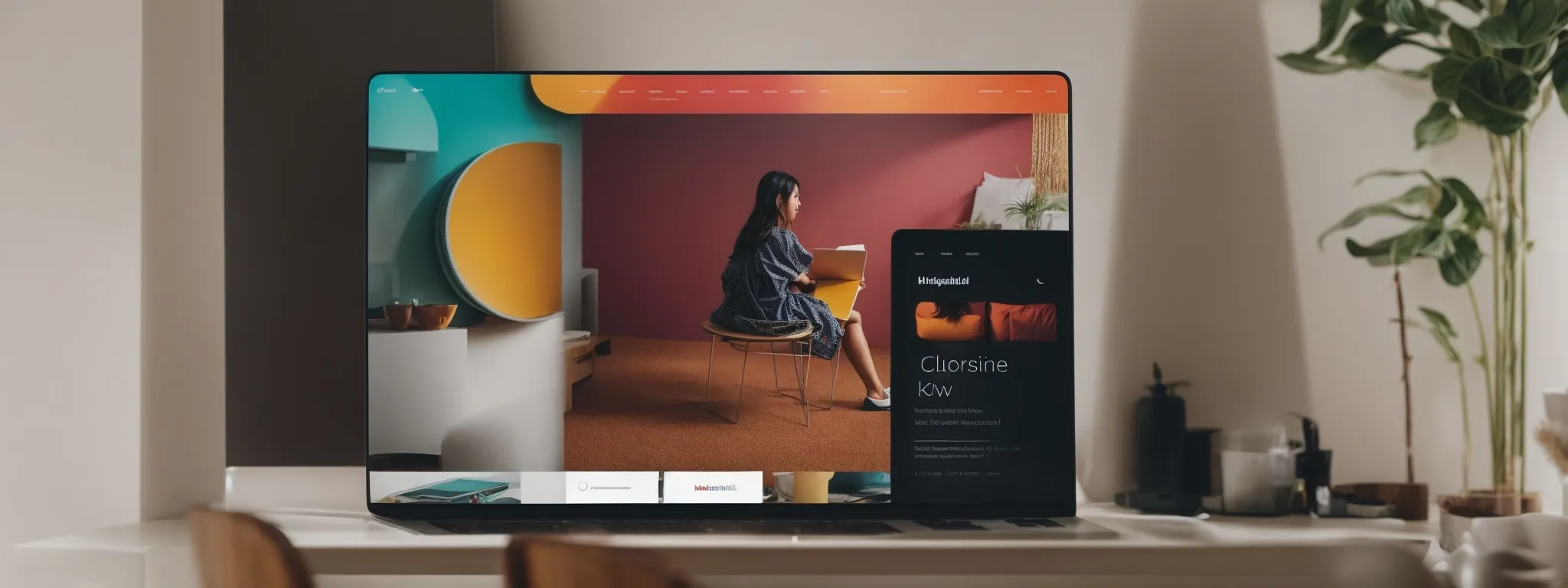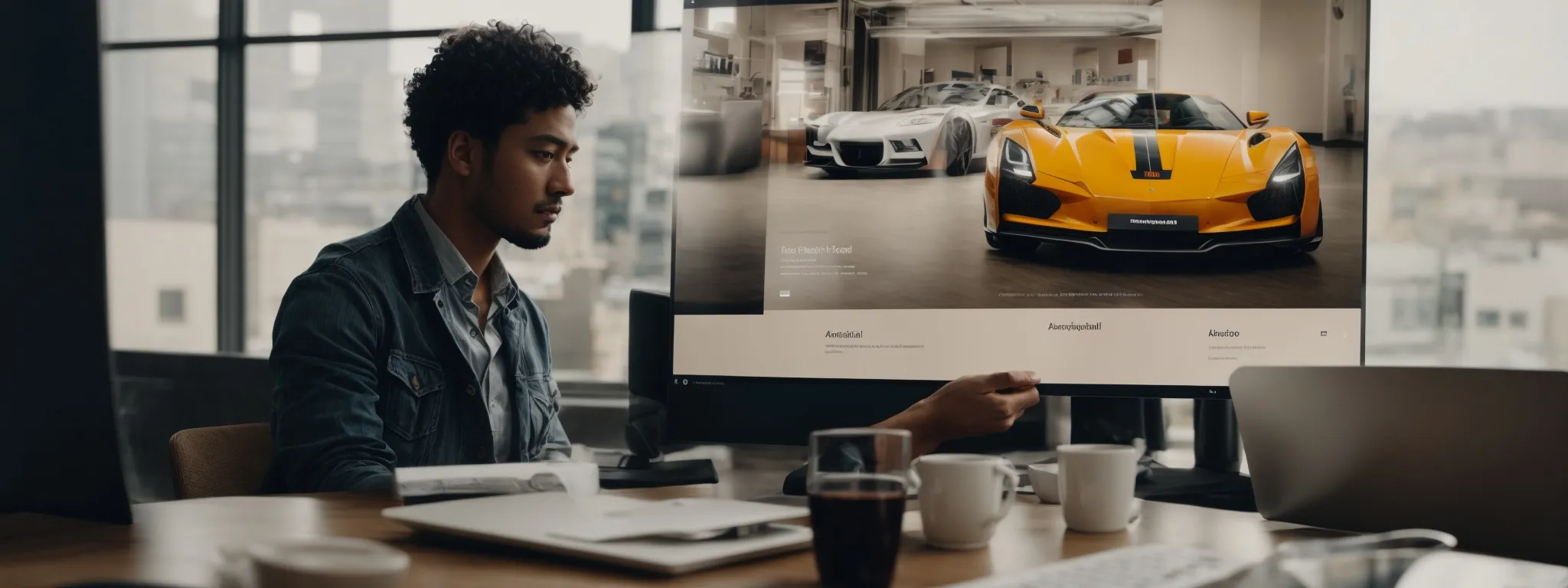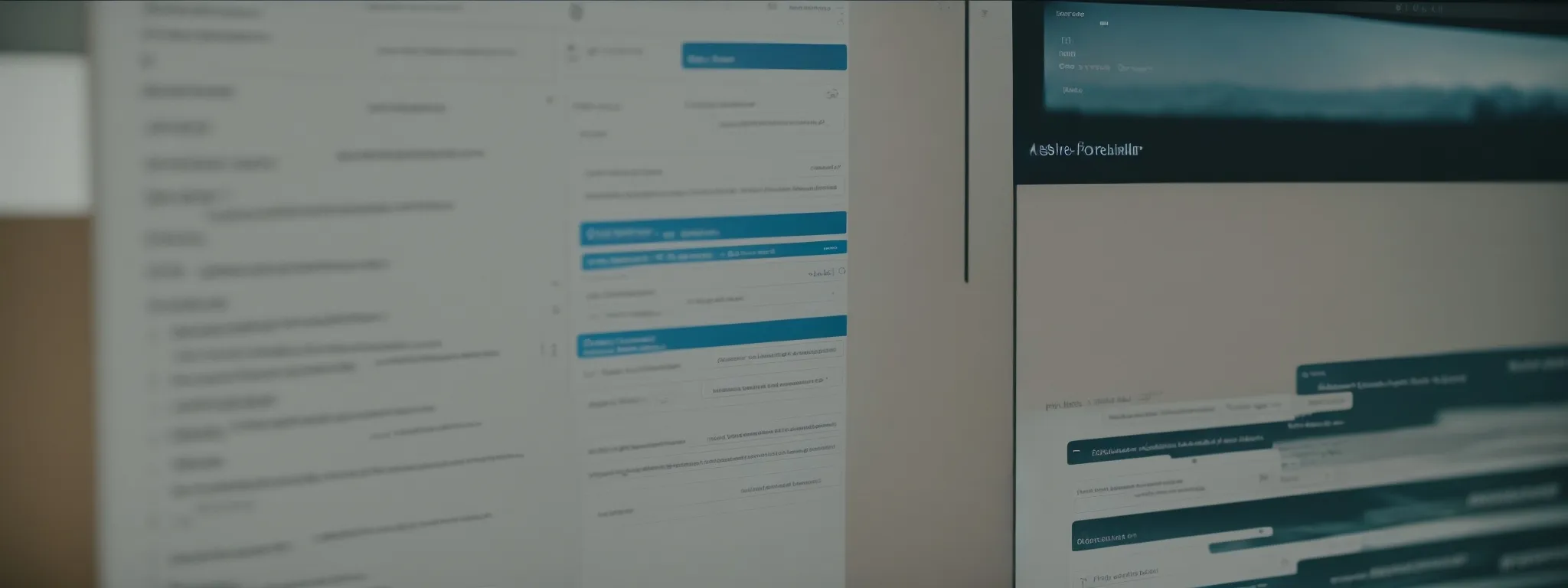6 Dreadful Design Mistakes That’ll Ruin Your SEO
Avoid These Dreadful Design Mistakes to Protect Your SEO In the digital age, a well-designed website serves as the cornerstone of effective online marketing, but certain design […]
Avoid These Dreadful Design Mistakes to Protect Your SEO
In the digital age, a well-designed website serves as the cornerstone of effective online marketing, but certain design pitfalls can drastically undermine SEO efforts.
Business owners and web developers must navigate the delicate balance between aesthetics and functionality to ensure that website visitors are not only pleased by what they see but also able to find the content via search engines.
A lapse in areas like mobile responsiveness or page load speeds can push a website painfully down in search engine rankings.
To aid in this complex endeavor, examining the most common web design mistakes and their impact on SEO is essential.
Keep reading to discover how sidestepping these errors with LinkGraph’s expert SEO services can elevate your online presence.
Key Takeaways
- Effective Web Design Balances Aesthetics With Functionality, Optimizing User Experience and SEO
- Overusing Design Elements, Particularly Multimedia, Can Impede Load Times and Negatively Affect SEO
- Simplifying URL Structures Enhances Usability for Visitors and Crawl Efficiency for Search Engines
- Color Contrast Is Crucial for Readability and Website Accessibility, Impacting User Experience and SEO Favorably
- Regular Contrast Checks Should Be Integrated Into the Design Process to Maintain Adherence to SEO and UX Best Practices
Recognize and Avoid Overusing Elements on Your Site

In the realm of website development, a sound balance between aesthetics and functionality remains paramount.
Website owners must vigilantly identify and regulate the deployment of various design elements that, while potentially eye-catching, may inadvertently impede page performance.
This demands not only a strategic approach to visual components such as graphic design, media files, and color schemes but also a meticulous consideration for the underpinnings of site architecture, including navigation pathways.
By harmonizing design aspects with an unwavering commitment to page speed and by streamlining the labyrinth of site navigation, businesses can deliver an optimized user experience poised to bolster search engine rankings.
Identifying Elements That Harm Page Performance
When crafting a digital presence, website developers often prioritize the allure of cutting-edge graphic designs and an abundance of high-resolution product images. Yet, these choices can backfire, as heavier media files strain loading times and elevate bounce rates, alerting search engines to potential user experience issues.
Diligent SEO experts understand that excessive creativity in web design can also lead to cluttered layouts packed with design elements, distracting visitors from the essential conversion pathways. It’s crucial to navigate the fine line where visual appeal synergizes with performance, ensuring that each design choice contributes positively to the overall website SEO profile.
Balancing Design Aspects With Page Speed
Executing a harmonious balance where website aesthetics do not compromise load speed is a nuanced task, with direct implications for SEO. LinkGraph’s SEO Services are acutely aware of this relationship, deploying strategic optimizations that ensure vivid designs align with the nimble agility required by today’s user preferences, thereby supporting website serps.
A key tenet that LinkGraph’s expertise hinges upon is the implementation of scalable media files and selective use of graphic design to create visually compelling yet rapid-loading web pages. This meticulous restraint in design choices is essential, as it not only preserves the integrity of a site’s aesthetic appeal but also protects search engine rankings by maintaining low bounce rates and high visitor retention.
Streamlining Navigation and Site Architecture
Streamlined navigation and intuitive site architecture are not just buzzwords—they are foundational elements that shape the user experience and influence search engine results. A well-organized website ensures visitors locate the desired information swiftly, compelling them to engage rather than abandon the journey: a direct factor in reducing bounce rate and improving SEO standings.
| Aspect | Importance for SEO | Impact on User Experience |
|---|---|---|
| Streamlined Navigation | Facilitates easier indexing by search engines | Reduces time to find information, lowers frustration |
| Intuitive Architecture | Boosts relevance for search queries | Ensures a logical flow, enhancing user satisfaction |
Website developers and designers at LinkGraph recognize the significance of these aspects and meticulously sculpt the website’s architecture to cater to both search engine algorithms and human behavior. They craft navigational structures that not only provide clear pathways for website crawlers but also resonate with the human penchant for simplicity and ease of access—streamlining the visitor’s digital voyage and securing SEO success.
Prioritize Mobile Optimization to Boost SEO

In today’s digital landscape, the shift towards mobile-first indexing by search engines underscores the critical necessity of optimizing websites for mobile devices.
A responsive, mobile-friendly website is not just an additional feature—it’s a fundamental component that can drastically sway search engine rankings.
Website owners, therefore, must invest in responsive design features and regularly conduct mobile usability testing to ensure their site meets the stringent demands of modern search algorithms.
LinkGraph’s suite of SEO services addresses these core areas, helping to transform websites into formidable contenders within the mobile-centric arena of online marketing.
Understanding the Impact of Mobile-First Indexing
Embracing the shift to mobile-first indexing, search engines now use the mobile version of a website as the primary source for ranking and indexing. With this change, website owners are urged to ensure their mobile sites are fully optimized, ensuring their digital offerings are evaluated favorably by the algorithms that dictate visibility in search engine results.
LinkGraph’s expertise in mobile optimization is integral for companies aiming to adapt to this paradigm. Their SEO services include a thorough analysis of mobile site performance, which in turn supports the elevation of a site’s status within the competitive framework of search engine rankings.
Implementing Responsive Design Features
In the era of smartphones and tablets, responsiveness in web design is not just beneficial but essential. LinkGraph equips website owners with responsive design features that ensure an optimal viewing experience across a range of devices, contributing to stronger SEO and higher user engagement.
With diligence, the LinkGraph team guarantees that every web page dynamically adjusts to fit the screen size of the device in use: a mobile phone, a tablet, or a desktop. Site visitors experience seamless navigation and readability, thereby reducing bounce rate and signaling quality to search engines:
| Design Feature | SEO Benefit | User Experience Advantage |
|---|---|---|
| Responsive Layouts | Increases mobile usability score | Improves accessibility and ease of use on any device |
| Dynamic Content Adjustment | Enhances content visibility for indexing | Ensures legibility and interaction regardless of screen size |
Testing for Mobile Usability Issues
LinkGraph’s comprehensive SEO services underscore the importance of identifying and addressing mobile usability issues through meticulous testing. By scrutinizing websites across a spectrum of mobile devices, their experts pinpoint and rectify any glitches that could tarnish user experience and, by extension, harm search engine standings.
Proactive resolution of these challenges is critical as it ensures that every visitor, regardless of their chosen device, enjoys a frictionless digital experience, affirming the client’s commitment to accessible web design and solidifying their SEO performance.
Keep Important Information Text-Based

In the intricate dance of web development, SEO and design elements must move in harmony to create a website that not only appeals to the eye but also to the meticulous algorithms of search engines.
One misstep frequently encountered is the overreliance on graphics to convey vital information, often embedding text within images.
While visually engaging, this practice can create significant barriers to content being indexed by search engines, as it obscures the very words that could improve search result rankings.
Embracing the power of HTML and CSS to stylishly present text ensures that all pivotal details remain not only visible to the audience but readily accessible to search engine crawlers, thereby reinforcing both the crawlability and the indexability of the information contained within the website.
The Downside of Embedding Text in Images
Utilizing images as sole carriers of critical textual information presents a severe SEO hurdle: search engines struggle to decipher text encapsulated within graphic elements. This limitation stifles a website’s potential to resonate within search algorithms, thereby inhibiting the content’s capacity to rank effectively.
Businesses often succumb to this design mistake, neglecting the ramifications of search engine crawlers’ inability to extract and comprehend text intertwined with visual files. Effectively, this practice is akin to withholding valuable content from search engines, a scenario that could lead to diminished online visibility:
- Text within images is often non-indexable, leading to missed opportunities in search engine results.
- Core messages trapped in graphics may escape analytical algorithms, impairing SEO performance.
- Keywords crucial for targeting are rendered inert when buried in image-based text, thwarting optimization efforts.
Using HTML/CSS to Style and Position Text
Web developers and designers at LinkGraph harness the Robust Capabilities of HTML and CSS to artistically format text without sacrificing SEO integrity. These technologies ensure that vital information is not only discernible to search engines but also presented with an aesthetic finesse that enhances user engagement.
Effective use of HTML and CSS mitigates the risk of obscuring content within graphic files, affording businesses the dual benefits of captivating design and improved search engine visibility. Deploying text in a search-friendly format while maintaining the visual integrity of a site constitutes a strategic approach that aids in optimizing a site’s presence within search results:
- Craft text-heavy areas ensuring content is easily indexed.
- Employ CSS to style text, maintaining readability across devices.
- Integrate SEO-favored techniques like proper use of heading tags and alt attributes.
Ensuring All Information Is Crawlable and Indexable
For a website’s content to reach its full SEO potential, it’s paramount that every snippet of important information is easily crawlable and indexable by search engines. The professionals at LinkGraph ensure this by deploying structured data and sitemaps: essential tools that guide search engine bots through a website’s content hierarchy with precision and efficiency.
| SEO Element | Function | Benefit |
|---|---|---|
| Structured Data | Organizes content into a standardized format | Facilitates understanding and indexing by search engines |
| Sitemaps | Provides a blueprint of a website’s structure | Assists search engine bots in efficient content navigation |
By meticulously constructing metadata and optimizing the robots.txt file, LinkGraph further refines the accessibility of content. This foundation ensures that the digital footprint of a website is not only visible but stands out in the vast expanse of the internet, endorsing a brand’s message through clarity and findability in search engine results.
Design Effective CTAs for Better Engagement

Critical to the success of any online marketing effort, the Call to Action (CTA) is the fulcrum upon which visitor engagement and conversion balance.
A strategically designed CTA does not merely beckon a visitor to take the next step; it is a sophisticated blend of form and function—crafted to guide users toward a desired action without hesitation.
The savvy business owner, web developer, or content marketer must recognize that the clarity of purpose, visibility, and allure of their CTAs directly influence not only user response but also search engine valuation of their website’s user experience.
As such, exploring topics like the precise articulation of CTA verbiage, the implementation of design best practices for optimal CTA placement, and the data-driven revisions instigated by A/B testing form a triad of strategies to amplify engagement and refine an effective CTA strategy.
Clarifying the Purpose of Your CTAs
Clear and compelling Calls to Action (CTAs) are central to guiding visitors towards the desired objective, be it making a purchase, signing up for a newsletter, or downloading a resource. Each CTA must convey its message with precision, leaving no room for ambiguity, thereby enabling a smoother transition for the visitor towards the conversion goal.
LinkGraph’s expert strategies for designing CTAs revolve around communicating value and urgency, maintaining an uncluttered visual identity that draws the user’s focus to the CTA. This laser-focused clarity not only boosts user engagement but also aligns perfectly with the nuanced demands of search engine algorithms, supporting the site’s SEO vitality.
Placement and Design Tips for CTAs
Effective CTAs are strategically positioned to catch the user’s eye immediately upon entering the web page or after engaging with the content. LinkGraph employs data-driven techniques to identify the prime real estate for placement – whether it be above the fold for instant visibility or at the conclusion of a compelling piece of content, ensuring a natural progression towards action.
Moreover, the design of a CTA is not a detail that LinkGraph takes lightly; it demands a marriage of brand-consistent color schemes and intelligible typography that stands out without jarring the user experience. The successful orchestration of these visual cues is crucial for maintaining a clear pathway to conversion, seamlessly integrating with the user’s journey and supporting the overarching goal of bolstering search engine rankings.
A/B Testing to Refine CTA Strategy
A/B testing emerges as a pivotal method for LinkGraph to quantitatively assess the efficacy of different CTA iterations. This systematic approach allows the simultaneous deployment of variant designs to determine which resonates more profoundly with the audience, paving the way for data-informed enhancements to both user interaction and SEO benefits.
With each test, subtle nuances in language, color, and placement are scrutinized, unveiling insights that refine the CTA strategy. LinkGraph’s commitment to optimization through A/B testing ensures CTAs are not just visually appealing, but are also instrumental in driving conversions and improving the website’s search engine standing.
Rethink Pop-Up Strategies to Retain Users

In an environment where user experience is intricately tied to search engine performance, design choices have far-reaching consequences for online visibility.
Among these, the utilization of pop-ups can be a controversial topic, as their intrusive nature can lead to adverse effects on both user engagement and SEO.
As website owners confront this design dilemma, they must assess the negative impact of pop-ups on search engine rankings, while also exploring alternative engagement techniques that align with SEO best practices.
The challenge then becomes crafting pop-ups that are not only user-friendly but also compliant with search engines’ guidelines, ensuring that these digital prompts enhance, rather than hinder, the user journey.
Assessing the Negative Impact of Pop-Ups on SEO
Pop-ups, while often deployed with the aim of immediate engagement or conversion, can inadvertently disrupt the user experience, a factor closely scrutinized by search engines when determining SEO rankings. These intrusive elements, particularly when overused or poorly timed, can prompt swift exits by visitors, signaling to search engines that the webpage may not offer a positive user experience.
Experts at LinkGraph caution against the overuse of pop-up features, recognizing the delicate balance required to serve marketing objectives without compromising search engine perceptions of user satisfaction. When search algorithms detect high bounce rates potentially caused by intrusive pop-ups, this may lead to a decline in the site’s search engine results positioning, emphasizing the need for strategic pop-up implementation.
Exploring Alternative Engagement Techniques
In the pursuit of maintaining a user-friendly interface without compromising on user engagement, LinkGraph champions alternative strategies over conventional pop-up tactics. For instance, crafting an immersive narrative throughout the website content can organically lead visitors to a discrete, yet persuasive, call-to-action (CTA).
| Engagement Technique | User Experience Focus | SEO Value |
|---|---|---|
| Narrative-Driven CTAs | Enriches content interaction without disruption | Encourages natural user flow enhancing time on site metrics |
| Discrete Exit-Intent Offers | Provides value with minimal intrusion | Improves conversion rates while maintaining SEO health |
By Implementing Subtler, Value-Driven Touchpoints such as exit-intent offers or personalized messages based on user behavior, LinkGraph’s SEO services ensure that the balance is tipped toward enhanced user engagement. These techniques foster an environment where visitors feel valued and not pressured, resulting in higher retention and better SEO outcomes.
Designing User-Friendly and SEO-compliant Pop-Ups
Designing pop-ups that seamlessly integrate with a website’s content requires a nuanced understanding of user behavior and SEO guidelines. LinkGraph’s SEO services Revitalize Pop-Up Implementation, focusing on less intrusive formats that appear at contextually appropriate moments, ensuring they aid rather than obstruct the user’s online journey.
- Create pop-ups that are timely and relevant to the content the user is interacting with.
- Employ moderate use of pop-ups to prevent overwhelming the user and causing navigation disruption.
- Ensure pop-ups are easily dismissible, granting users control over their browsing experience.
By crafting user-friendly pop-ups that align with Google’s best practices, LinkGraph assists clients in enhancing engagement without sacrificing SEO performance. This strategic approach to design leads to an equilibrium where marketing goals are met, user experience is respected, and the integrity of search engine rankings is upheld.
Harness the SEO Power of Your 404 Error Pages

A 404 error page can either be a stumbling block or a strategic tool in the architecture of a website.
Misguided design decisions in these areas can disrupt user experience and tarnish SEO efforts.
Conversely, an astutely crafted 404 page enhances navigation, reinforcing visitor retention and contributing positively to search engine rankings.
This section demystifies the benefits of diligently designed 404 pages, enumerates best practices for creating resourceful error pages, and underscores how such pages, when optimized, serve to bolster user experience and refine a brand’s SEO landscape.
Benefits of a Well-Designed 404 Page
A well-designed 404 error page turns a potential setback into an opportunity for visitor retention and brand reinforcement. By incorporating a strategic blend of language, visuals, and navigation prompts, such pages mitigate frustration and encourage visitors to continue their journey on the site.
Optimizing 404 pages effectively communicates to users that their destination may have been misplaced, but their desired content is still within reach: an approach that not only preserves user experience but also signals to search engines the website’s commitment to attentive service.
| Error Page Element | User Experience Enhancement | SEO Benefit |
|---|---|---|
| Customized Message | Mitigates visitor frustration and disorientation | Reduces bounce rate by encouraging further site exploration |
| Navigation Prompts | Offers direct links to major site areas or content | Facilitates search engine crawling and user journey continuity |
| Search Functionality | Empowers users to take immediate action in locating content | Increases time on site and engagement levels |
Best Practices for Creating Helpful 404 Pages
Constructing user-centred 404 pages involves a strategic understanding of both visitor expectations and SEO principles. A well-executed 404 page guides users back to the main site with ease, featuring clear messaging and a simple navigational structure that reduces confusion and bounce rate.
In crafting these error pages, LinkGraph stresses the importance of providing alternative links to content, an easy-to-use search bar, and perhaps a quip or graphic that aligns with the brand’s voice, thereby transforming a possible exit point into a continued exploration of the site:
| 404 Page Element | User Engagement Strategy | SEO Consideration |
|---|---|---|
| Communicative Messaging | Clarifies the error and suggests a way forward | Prevents immediate departures, enhancing user retention |
| Link Suggestions | Directs users to other relevant areas on the site | Maintains the flow of site traffic and reduces lost engagement |
| Search Bar Integration | Empowers users to navigate directly to the content they seek | Encourages active interaction with the site’s search functionality |
LinkGraph optimizes these 404 pages not only to offer support to visitors who have encountered a dead end but also to ensure that these pages contribute positively to the site’s overall SEO landscape, turning errors into opportunities for both the company and the user.
Using Error Pages to Improve Overall UX and SEO
Creatively leveraging 404 error pages, the team at LinkGraph transforms these potential detours into an integral aspect of a website’s user experience (UX) and SEO strategy. A tactfully designed error page invites continued exploration, subtly guiding visitors back into the website’s fold, and signaling to search engines an adroit handling of user flow—even in the face of broken links or removed content.
By infusing error pages with the right communicative tone and actionable guidance, LinkGraph ensures these overlooked web corners enhance user satisfaction and search engine favorability. Such strategic consideration not only minimizes potential disruption to the user’s navigation but also strengthens the website’s stature in the algorithmic evaluation of useful, user-driven design—bolstering its SEO resilience.
Realize the Negative SEO Impact of Slow Loading Times

In an age where digital competition is fierce, the swiftness with which a website loads is not merely a convenience but a critical component deeply intertwined with user experience (UX) and search engine optimization (SEO).
The speed of a website holds the power to captivate or repel visitors, acting as a silent arbitrator of a business’s online success.
To aid those entrusted with the optimization of digital environments, a selection of diagnostic tools is available to pinpoint elements that drag down speed, while an array of techniques awaits deployment to enhance the intricacies of website performance.
Focusing on speed is not only about appeasing the demands of today’s fast-paced society but about embracing the intricate dance of technology that aligns the tempo of a site with the rhythm of search engine requirements and user satisfaction.
The Relationship Between Speed, UX, and SEO
The velocity at which a Website Unfurls Its Content to a user is a key determinant of the user’s experience and, by extension, the site’s SEO stature. A swiftly loading site fosters engagement, reducing bounce rates, and enhancing dwell time – factors that search engines, such as Google, factor into their ranking algorithms. It is the logic of accessibility, where speed ensures content is not just available but invitingly consumable for the visitor.
Within the convergence of loading speed, user experience, and SEO, lies a critical balance that website developers and SEO strategists from LinkGraph strive to achieve. This interplay dictates that speed optimization is not an isolated technical endeavor but a core aspect of a holistic SEO strategy, designed to amplify the user’s seamless interaction with a site, thereby positively influencing search engine rankings.
Tools for Diagnosing Site Speed Issues
LinkGraph’s suite of diagnostic tools addresses the critical concern of slow loading times, the bane of SEO and user experience. By leveraging advanced technology, these tools delve deep into the architecture of clients’ websites, identifying elements that compromise speed and providing actionable insights.
- Comprehensive website audits highlight problematic scripts and excessive HTTP requests.
- Performance metrics offer a detailed view of the site’s response times and bottlenecks.
- Advanced analytics enable the correlation between page speed and user behavior patterns.
These analytical reports not only pinpoint inefficiencies but also empower website owners with data-driven strategies for optimization. With precise adjustments guided by LinkGraph’s expert analysis, websites can achieve improved load times, enhancing their search engine rankings and elevating the overall user experience.
Techniques to Improve Website Loading Times
Achieving faster loading times requires meticulous optimization of a site’s assets. LinkGraph champions the practice of compressing images and minifying code to hasten load speeds, ensuring visual elements and functionalities manifest quickly without sacrificing quality.
Moreover, LinkGraph advises on the strategic use of content delivery networks (CDNs) to distribute the hosting of files across multiple servers, thereby reducing latency and hastening access to the website’s content for users irrespective of their geographic location.
Don’t Let Flashy Multimedia Sabotage Your SEO

Within the digital space, the incorporation of eye-catching multimedia elements can be a double-edged sword, capturing the attention of visitors while potentially jeopardizing site performance and SEO standing.
Web developers and SEO experts must exercise a rigorous balancing act, seeking to harness the vibrancy of images and videos without inviting the negative ramifications associated with excessive use.
In this critical evaluation of multimedia implementation, one will explore strategies like image and video optimization to enhance loading times and creative alternatives for presenting visual content, ensuring the visual allure of a website harmoniously complements, rather than conflicts with, the overarching goal of solid search engine optimization.
Complications Caused by Excessive Multimedia Use
In a digital era where captivating visuals are highly prized, the pitfalls of overloading a website with multimedia are often underestimated. Excessive multimedia use can impede load times, leading to a deteriorated user experience and a consequent loss in search engine favorability.
LinkGraph’s seasoned professionals underscore that overindulgence in multimedia not only burdens server resources but also distracts from the core message, potentially diluting the brand’s communication. Moreover, it overwhelms the website’s architecture, threatening to eclipse the seamless user journey critical for maintaining robust SEO rankings.
Optimizing Images and Videos for Faster Loading
One cornerstone of effective media integration lies in the optimization of images and videos for swift loading. This involves utilizing compression techniques that reduce file size without degrading quality, assuring that visual content enhances rather than hampers user experience.
Essential actions in optimizing multimedia also include the proper selection of formats and the implementation of responsive design solutions to ensure media displays correctly across devices:
- Choosing next-gen formats like WebP for images that offer superior compression and quality.
- Implementing lazy loading so media files are only downloaded as they come into the viewport, reducing initial load time.
- Encoding videos with the latest codecs to achieve a balance between file size and video clarity.
Alternative Methods to Display Visual Content
To alleviate the SEO impact of multimedia excess, LinkGraph employs innovative strategies that ensure visual content engages without overwhelming. One such methodology involves using CSS animations and transitions, which provide dynamic user interactions that are less resource-intensive than video and can be indexed more effectively by search engines.
Another technique leveraged by LinkGraph is utilizing thumbnails linked to higher resolution content, permitting a quick preview that loads the full-scale media only upon user request. This thoughtful approach ensures that initial page load times remain swift, thereby safeguarding the site’s SEO integrity while still offering an enriched visual experience for committed visitors.
Avoid Complex URL Structures for Better Indexing

The foundation of a user-friendly and SEO-efficient website lies in the simplicity and organization of its URL structures.
Complicated or vague URLs contribute to confusion not only for the visitor but also for search engine crawlers, which may hinder a site’s ability to rank optimally.
Understanding the SEO consequences of poor URLs is an essential step toward streamlining the user experience and enhancing a website’s digital footprint.
Creating a clear and concise URL naming convention, coupled with implementing SEO-friendly URL structures, is vital for achieving a clean navigational hierarchy that search engines can index with precision.
This attention to detail fortifies the infrastructure of a website’s SEO strategy, shaping an essential framework for online visibility and success.
Understanding the SEO Consequences of Poor URLs
Complex or non-intuitive URL structures can significantly disrupt a website’s search engine presence. When URLs become convoluted, they thwart the search engine’s ability to crawl and index web pages efficiently, jeopardizing the site’s visibility in search results and confusing the user journey.
A direct consequence of intricate URL patterns is their negative impact on link-sharing usability. Concise, descriptive URLs are more likely to be shared accurately, increasing the potential for organic backlinks, which are tantamount to an endorsement in the realm of SEO:
| URL Component | SEO Impact | User Experience Concern |
|---|---|---|
| URL Length | Long URLs may be truncated in search results, losing communicative value. | Users find short URLs easier to remember and share. |
| Keyword Usage | Relevant keywords aid in aligning page content with search queries. | Descriptive keywords in URLs help users predict content on the page. |
| URL Readability | Readable URLs facilitate better crawling and indexing by search engines. | Clear URLs improve user trust and engagement with the site. |
Accordingly, website owners who simplify their URL structures provide a dual benefit: enhancing search engine indexing procedures while presenting a clearer, more navigable website to visitors. Clear and SEO-friendly URLs form the stepping stones towards an optimized, user-centric website, crucial for maintaining an advantageous position in search engine results.
Creating a Clear and Concise URL Naming Convention
A clear and concise URL naming convention is essential for search engine recognition and user navigation. By structuring URLs logically, LinkGraph enhances a website’s accessibility and comprehensibility for both search engine crawlers and visitors.
Adherence to a well-defined URL protocol can drastically improve a site’s SEO performance and user experience:
- LinkGraph ensures URLs contain relevant keywords that mirror page content, boosting search relevance.
- They adopt a standardized format for URLs across the site, promoting consistency.
- The team avoids unnecessary parameters and dynamic URLs that complicate crawling and indexing processes.
LinkGraph’s strategic approach simplifies site architecture, allowing both users and search engines to navigate and understand a website with ease, driving traffic and elevating search result rankings.
Implementing SEO-friendly URL Structures
LinkGraph excels in establishing SEO-friendly URL structures, an initiative that underscores the importance of facilitating effortless crawling and indexing by search engines. They meticulously configure URLs to be descriptive and succinct, aligning them with the core content and thematic relevance of each web page, thus empowering both search engines and users with clear direction.
The dedication to streamlined URL architecture ensures a frictionless user experience, while concurrently enhancing the website’s visibility in search engine results. LinkGraph’s expertise transforms potentially ambiguous web addresses into beacons of clarity, guiding visitors and search algorithms through a website’s offerings with unparalleled precision.
Never Underestimate the Importance of Color Contrast

In the meticulous crafting of a website’s aesthetic, color contrast emerges as a crucial factor that extends beyond mere visual appeal to significantly impact readability and user experience (UX).
The strategic selection and application of colors not only engenders an immediate emotional response but also governs the ease with which users consume content.
As such, web developers and designers are tasked with ensuring that their color choices meet stringent accessibility standards, harmonize with user expectations, and contribute positively to the site’s SEO.
Employing contrast evaluation tools during the design process represents a proactive approach to maintaining readability, enhancing UX, and securing the website’s favor with search engines.
How Color Contrast Affects Readability and UX
The interplay of color contrast on a website is pivotal in shaping user accessibility and overall engagement. An optimized contrast ratio facilitates swift comprehension, allowing visitors to easily navigate and digest content, enhancing the overall user experience and accommodating a diverse audience spectrum.
Web design professionals at LinkGraph prioritize color contrast considerations, recognizing that appropriate color differentials not only captivate attention but also significantly affect readability. By strategically deploying color schemes that comply with accessibility guidelines, they ensure content clarity and foster a comfortable visual environment for every user, which indirectly supports SEO through improved user satisfaction metrics.
Tools to Test for Adequate Color Contrast
LinkGraph leverages advanced contrast evaluation tools, meticulously analyzing color schemes to ascertain their effectiveness in fostering content clarity. These powerful applications simulate various user scenarios, providing invaluable feedback on contrast ratios to ensure visual design meets the highest standards of accessibility and complements the site’s UX and SEO strategies.
Recognizing that optimal readability is essential for website visitor retention, LinkGraph’s color contrast assessments form a critical part of their web development process. Their tools provide actionable insights, enabling designers to adjust color palettes effectively, thus crafting interfaces that serve both aesthetic and functional purposes, invariably contributing to a site’s robust SEO profile.
Integrating Contrast Checks Into the Design Process
Incorporating color contrast checks into the design workflow is a vital step for web developers and designers at LinkGraph. Their approach is meticulous, initiating checks early in the design phase to allow for timely adjustments that align with SEO and UX objectives.
Ensuring that these evaluations are embedded into routine development practices enables a consistent application of accessible and visually appealing designs. The integration of contrast checks helps safeguard against oversight and upholds the commitment to an inclusive online space:
- Contrast checks are performed at multiple stages of the design process, safeguarding accessibility from the outset.
- Adjustments and refinements are made in response to contrast check outcomes, ensuring compliance with SEO best practices and user experience enhancement.
Conclusion
In conclusion, website design significantly influences SEO, and avoiding common design mistakes is crucial for maintaining your site’s search engine rankings and user experience.
Keep multimedia elements optimized to ensure they don’t slow down your site and hamper SEO efforts.
Embrace clear navigation and intuitive site architecture to aid both users and search engine crawlers.
Ensure that CTAs are effectively designed and strategically placed to enhance user engagement without being intrusive.
Prioritize text-based information for better indexing and use responsive design features for optimum mobile user experiences.
Maintain simple URL structures for easier indexing, and don’t underestimate the importance of color contrast for readability and accessibility.
Implementing these practices will not only prevent common design pitfalls but also create a more user-friendly and SEO-effective website.















































































